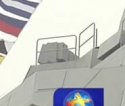I will too. But not yours. No offense.

I guess neither of us will know either way.
This is a total straw man argument. IFF arrays transmit an interrogation signal and listen for an automatic reply from a friendly IFF transponder. Whoever told you that IFF interrogators listen for a "reflection" signal? Nobody. Hence your straw man fallacy. Notice that the main radar array is not involved in the slightest in this transaction. The IFF array produces the interrogation signal AND listens for a reply signal; this is possible because the IFF is an AESA and by definition has both transmit and receive capability; your fallacy is trying to argue that someone in this universe claimed that the transmitted signal is what the IFF array is listening for after it interrogates an unknown target. This is the key to understanding why IFF arrays can be so small compared to a main radar array; it doesn't have to have any degree of resolution discrimination; it just has to transmit in the general direction of the target and listen for a coded response, which also doesn't need high resolution. Hence, a bar array arranged in a horizontal fashion to maximize azimuth resolution but couldn't give two shites about elevation resolution. Since the bar arrays cover 360 degrees and functions independently of the main radar array there is no need for IFF arrays to align with the main radar arrays.
Except that if the signal has to be traveling further, even a communication signal has to be beam formed to achieve the range. And when you use a phase array for that, if the beam is steered off center it loses gain, and won't have the gain as if the target is on center. You don't seem to understand that both the transmit and receive gain of an antenna depends greatly on the direction it is facing, and that is true even with mechanical antennas. That is why IFF arrays even with mechanical arrays also and always face and are fixed with the direction of the antenna.

This does not look like a small IFF array on the bottom. Even with communication, bigger arrays have better receive gain because a larger area catches more of the radio signals.
So even if I were to use a smaller IFF array, It would still rather go on top of the main radar array rather than an offset position, just like on the 052D. There is nothing stopping for the ship designers from doing so.
And lol, why do even you think the bar is one entire single array by itself, with mostly horizontal resolution and don't give a shite about elevation? What if I tell you the "bar" is a series of independent transponders. Its not a "single" array, but a number of square arrays, each with its own transponder.
IFF with a set of four transponders.

And each square you see is a transponder by itself.


If each transponder happens to be a mini phase array by ttself, it would be equal square with the equal ability to beam form for both the azimuth and the elevation. Each transponder would have its own beam form from one another.
I have already shown to you the larger bar arrays is clearly segmented.

Each segment is an transponder all by itself, and if there is a beam steering antenna in front of the transponder, it would be a square one that can scan both the horizontal and the vertical. Those are pretty large transponders.
I cannot see close enough if the smaller quarter of arrays are also segmented on the back. Two things are possible. First is that if they are radar, they are LPI AESA X-band surface scanning and navigation array that is used by the ship as it goes around. They would be in the right position for it. Second, if they are IFF, they would be the IFF for the X-band arrays on the integrated mast as they are in the proper quadrant for them, and in the right position for it. IFF are either above or below the main radar they serve for.





